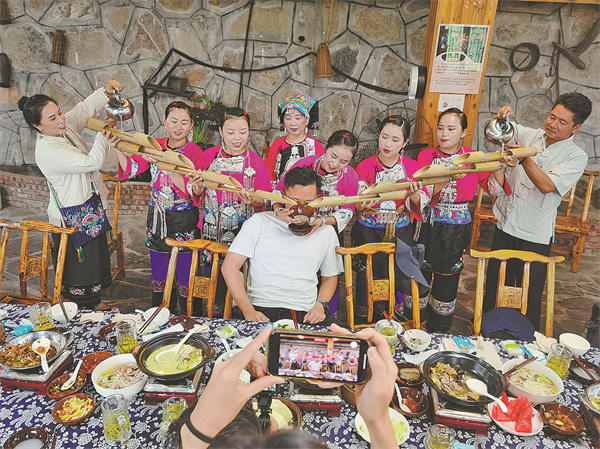
Villagers welcome a guest by cascading liquor down bamboo chutes in Shibadong village in Xiangxi Tujia and Miao autonomous prefecture in Hunan province on Aug 4. [WANG JING/CHINA DAILY]
Arts boost incomes for minority groups as nation continues drive for rural vitalization. Zhao Yimeng reports from Changsha, Hunan province.
Ethnic arts and crafts have become a profitable rural industry, lifting villages in Hunan province out of poverty and contributing to rural vitalization.
About 97.5 percent of villagers in Hequn, in northwestern Hunan's Zhangjiajie city, are members of the Bai ethnic group. Many of the Bai people are making a living selling cloth made with tie-dyeing, a method involving the application of colors or patterns to textiles that they use to make their traditional clothing.
About half the villagers in Hequn participated in a workshop last month on tie-dyeing by Zhang Pihe, a 43-year-old Bai woman born in Dali city, Yunnan province.
Zhang inherited the skill from her grandm Zhang sai...t-alig������������������������������������������������������������������������������������������������������������������������������������������������������������������������������������������������������������������������������������������������������������������������������������������������������������������������������������������������������������������������������������������������������������������������������������������������������������������������������������������������������������������������������������������������������������������������������������������������������������������������������������������������������������������������������������������������������������������������������������������������������������������������������������������������������������������������������������������������������������������������������������������������������������������������������������������������������������������������������������������������������������������������������������������������������������������������������������������������������������������������������������������������������������������������������������������������������������������������������������������������������������������������������������������������������������������������������������������������������������������������������������������������������������������������������������������������������������������������������� he said. ...t-alig����������������������������������������������������������������������������������������������������������������������������������������������������������������������������������������������������������������������������������������������������������������������������������������������������������������������������������������������������������������������������������������������������������������������������������������������������������������������������������������������������������������������������������������������������������������������������������������������������������������������������������������������������������������������������������������������������������������������������������������������������������������������������������������������������������������������������������������������������������������������������������������������������������������������������������������������������������������������������������������������������������������������������������������������������������������������������������������������������������������������������������������������������������������������������������������������������������������������������������������������������������������������������������������������������������������������������������������������������������������������������������������������������������������������������������������������������������������������������� the 68-ye...t-alig�����������������������������������������������������������������������������������������������������������������������������������������������������������������������������������������������������������������������������������������������������������������������������������������������������������������������������������������������������������������������������������������������������������������������������������������������������������������������������������������������������������������������������������������������������������������������������������������������������������������������������������������������������������������������������������������������������������������������������������������������������������������������������������������������������������������������������������������������������������������������������������������������������������������������������������������������������������������������������������������������������������������������������������������������������������������������������������������������������������������������������������������������������������������������������������������������������������������������������������������������������������������������������������������������������������������������������������������������������������������������������������������������������������������������������������������������������������������������������99f881afccff7726&type=jpg&jcrVer=1.0" border="0">
Women tie-dye fabric in Hequn village, Zhangjiajie, Hunan province, on Aug 5. [WANG JING/CHINA DAILY]
In 2018, women from the village began working with CRRC Group, the State-owned rail stock manufacturer, to make handicrafts featuring high-speed railway designs for the company.
"I never expected that we could earn money from the embroidery that was previously only used to decorate our clothing," Shi said. "The products are now being exhibited to the world, and we can make money by doing handicrafts at home."
Shibadong has been able to use its traditional Miao ethnic specialties, as well as agricultural products such as kiwi fruit and peaches grown in the mountains to help lift the village out of poverty.
The per capita income of the villagers has increased from 1,668 yuan in 2013 to 20,167 last year, and their collective income last year reached 2.68 million yuan, according to the Hunan Bureau of Rural Vitalization.
Before Shi Chengfu opened a homestay in the village in 2015, he earned as little as 10,000 yuan a year as a farmer. By venturing into tourism, he now earns an annual income of 80,000 yuan.
"We have benefited from the upgrading of roads and transportation," the 60-year-old said. "It used to take us a three-hour round trip to go to town from the village. Now, going to town is just a 10-minute drive."
Young people are now more willing to return to Shibadong to work as there are more opportunities thanks to the rural vitalization efforts, according to Shi Jintong, Party secretary of the village.
"Those who speak Mandarin well can work as tour guides, while others can work in the agricultural cooperatives," he said.
Source: China Daily








